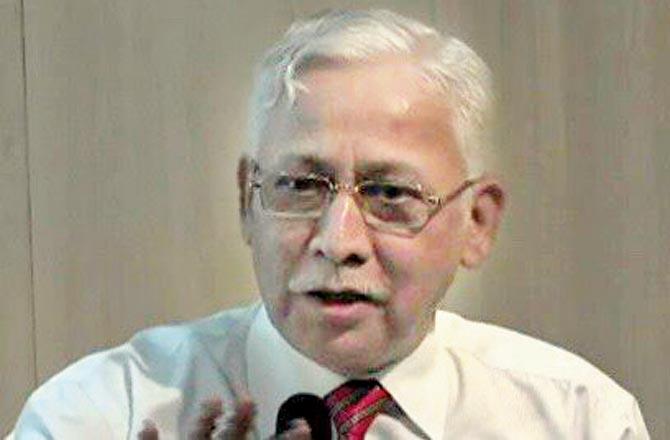City media consultant Ravi Nair lodges complaint against new TRAI tariff order, says channels make enough money from sponsors, producers and ads

Ravi Nair
Over a month after consumers of television content found themselves braving Telecom Regulatory Authority of India's (TRAI) new rules imposed on January 31, Mumbai-based media consultant Ravi Nair has written to the Mumbai Grahak Panchayat (MGP), objecting to the norms, and recommending an amicable solution instead.
ADVERTISEMENT
TRAI's new rules seek to make it simpler for viewers to choose what they wish to watch, instead of being bound by packs decided upon by the cable operator. The tariff is set at a monthly Network Capacity Fee (NCF) of Rs 130 (Rs 153 when GST is added) for 100 channels. These channels may include those that are Free To Air (FTA), or those that come with an additional cost (which may vary from Rs 0.50 paise to Rs 19 per month), which is then added to the NCF fee.

Shirish Deshpande
In conversation with mid-day, Nair terms the rates "obnoxious". "I am proposing a plan under which we don't need the [segregation between] FTA [and paid] channels," he says, pointing out that even though consumers may add the FTA channels to their pack of 100, they may not wish to watch them at all. The channels that they would wish to subscribe to may come with an added fee that the viewer may need to pay in addition to the NCF.
"If we do away with this [segregation of] FTA and paid channels, and pay Rs 2.50 or Rs 3 for every channel that we wish to consume, it could lead to a more consumer-friendly plan," he suggests. Nair basis his opinion on the theory that consumers rarely watch over 50 channels, and would hence pay an amount of Rs 125 per month, if they shell out Rs 2.50 for each channel. Their pack, he insists, would hence be cheaper, and aligned with their individual preferences.

How TV earns its money
Nair argues that the new norms are likely to make the TV conglomerates richer, and provide little aid to a viewer. "Channels earn money from the producers of the programs that they air, through commercials, sponsorship and brand endorsements as well. I don't wish to become a source via which they make more money. If a viewer pays [for a channel], he must not pay for advertisements. Let the channels stop airing ads in that case. The model should facilitate the interests of viewers and do away with additional costs which only make the TV conglomerates richer."
MGP president Shirish Deshpande backs Nair's claims, suggesting that the advertisement revenues garnered by channels are indeed "enormous". He finds reason in Nair's plea when the latter argues that the ceiling price of Rs 19 imposed on channels is high. "In a previous meeting with TRAI secretary Sunil Gupta, I too had raised this concern, but they claimed that the pricing had been arrived at following research. I feel the costs tilt in the favour of broadcasters and channel owners. This needs to be revisited because of the grievances of consumers. There must be an in-depth study carried out on pricing, and [benefits of] all stakeholders must be considered," he says, adding that knocking on the doors of the court would yield to little result since judges may not be best suited to negotiate on the price. "They might direct the issue back to TRAI."
Way forward for Nair
Deshpande says he finds merit in Nair's suggestions. "My colleagues are considering it. We have received multiple complaints from consumers, who, despite choosing what they want, are being charged more than what they were before." A press conference, he says, will be held after they have conducted sufficient research to pursue it further.
Understanding TRAI's norms:
- The new regulatory tariff introduces a monthly NCF of Rs 130 (Rs 153 with GST) for 100 channels. Should a viewer require more than 100 channels, an extra R20 is added for 25 additional slots.
- While some channels in this pack are Free To Air (FTA), others come at an additional cost, which may vary from Rs 0.50 paise to Rs 19 per month. If a viewer adds a paid channel to his pack, this amount is added to the NCF fee of Rs 130.
- Twenty-five DD channels are already added to the NCF pack of 100. They cannot be removed, implying that a user can add another 75 channels only.
- Users have the options of choosing channels a-la-carte, which is a single channel or in bouquet packs. For example, if a user chooses a bouquet of 10 channels worth Rs 120 per month, the bill will amount to: Rs 130 (NCF)+120 (bouquet pack) +18% GST.
- Viewers have the option of choosing HD or SD channels. However, one HD channel will count as 2 SD channels in the pack.
Also Read: TRAI: Jio added most subscribers in Nov 2018, followed by BSNL
Catch up on all the latest entertainment news and gossip here. Also download the new mid-day Android and iOS apps to get latest updates
 Subscribe today by clicking the link and stay updated with the latest news!" Click here!
Subscribe today by clicking the link and stay updated with the latest news!" Click here!






